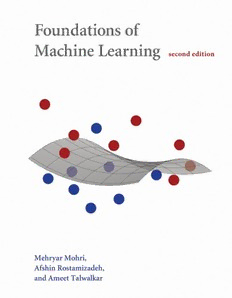Table Of ContentFoundations of Machine Learning
second edition
Adaptive Computation and Machine Learning
Francis Bach, Editor
A complete list of books published in The Adaptive Computations and Machine
Learning series appears at the back of this book.
Foundations of Machine Learning
second edition
Mehryar Mohri
Afshin Rostamizadeh
Ameet Talwalkar
The MIT Press
Cambridge, Massachusetts
London, England
c 2018 Massachusetts Institute of Technology
(cid:13)
All rights reserved. No part of this book may be reproduced in any form by any
electronic or mechanical means (including photocopying, recording, or information
storage and retrieval) without permission in writing from the publisher.
ThisbookwassetinLATEXbytheauthors. PrintedandboundintheUnitedStates
of America.
Library of Congress Cataloging-in-Publication Data
Names: Mohri, Mehryar, author. Rostamizadeh, Afshin, author. Talwalkar,
| |
Ameet, author.
Title: Foundations of machine learning / Mehryar Mohri, Afshin Rostamizadeh,
and Ameet Talwalkar.
Description: Second edition. Cambridge, MA : The MIT Press, [2018]
| |
Series: Adaptive computation and machine learning series Includes
|
bibliographical references and index.
Identifiers: LCCN 2018022812 ISBN 9780262039406 (hardcover : alk. paper)
|
Subjects: LCSH: Machine learning. Computer algorithms.
|
Classification: LCC Q325.5 .M64 2018 DDC 006.3/1--dc23 LC record available
|
at https://lccn.loc.gov/2018022812
10 9 8 7 6 5 4 3 2 1
Contents
Preface xiii
1 Introduction 1
1.1 Whatismachinelearning? 1
1.2 Whatkindofproblemscanbetackledusingmachinelearning? 2
1.3 Somestandardlearningtasks 3
1.4 Learningstages 4
1.5 Learningscenarios 6
1.6 Generalization 7
2 ThePACLearningFramework 9
2.1 ThePAClearningmodel 9
2.2 Guaranteesforfinitehypothesissets—consistentcase 15
2.3 Guaranteesforfinitehypothesissets—inconsistentcase 19
2.4 Generalities 21
2.4.1 Deterministicversusstochasticscenarios 21
2.4.2 Bayeserrorandnoise 22
2.5 Chapternotes 23
2.6 Exercises 23
3 RademacherComplexityandVC-Dimension 29
3.1 Rademachercomplexity 30
3.2 Growthfunction 34
3.3 VC-dimension 36
3.4 Lowerbounds 43
3.5 Chapternotes 48
3.6 Exercises 50
4 ModelSelection 61
4.1 Estimationandapproximationerrors 61
4.2 Empiricalriskminimization(ERM) 62
4.3 Structuralriskminimization(SRM) 64
vi Contents
4.4 Cross-validation 68
4.5 n-Foldcross-validation 71
4.6 Regularization-basedalgorithms 72
4.7 Convexsurrogatelosses 73
4.8 Chapternotes 77
4.9 Exercises 78
5 SupportVectorMachines 79
5.1 Linearclassification 79
5.2 Separablecase 80
5.2.1 Primaloptimizationproblem 81
5.2.2 Supportvectors 83
5.2.3 Dualoptimizationproblem 83
5.2.4 Leave-one-outanalysis 85
5.3 Non-separablecase 87
5.3.1 Primaloptimizationproblem 88
5.3.2 Supportvectors 89
5.3.3 Dualoptimizationproblem 90
5.4 Margintheory 91
5.5 Chapternotes 100
5.6 Exercises 100
6 KernelMethods 105
6.1 Introduction 105
6.2 Positivedefinitesymmetrickernels 108
6.2.1 Definitions 108
6.2.2 ReproducingkernelHilbertspace 110
6.2.3 Properties 112
6.3 Kernel-basedalgorithms 116
6.3.1 SVMswithPDSkernels 116
6.3.2 Representertheorem 117
6.3.3 Learningguarantees 117
6.4 Negativedefinitesymmetrickernels 119
6.5 Sequencekernels 121
6.5.1 Weightedtransducers 122
6.5.2 Rationalkernels 126
6.6 Approximatekernelfeaturemaps 130
6.7 Chapternotes 135
6.8 Exercises 137
7 Boosting 145
7.1 Introduction 145
7.2 AdaBoost 146
7.2.1 Boundontheempiricalerror 149
7.2.2 Relationshipwithcoordinatedescent 150
7.2.3 Practicaluse 154
Contents vii
7.3 Theoreticalresults 154
7.3.1 VC-dimension-basedanalysis 154
7.3.2 L1-geometricmargin 155
7.3.3 Margin-basedanalysis 157
7.3.4 Marginmaximization 161
7.3.5 Game-theoreticinterpretation 162
7.4 L1-regularization 165
7.5 Discussion 167
7.6 Chapternotes 168
7.7 Exercises 170
8 On-LineLearning 177
8.1 Introduction 178
8.2 Predictionwithexpertadvice 178
8.2.1 MistakeboundsandHalvingalgorithm 179
8.2.2 Weightedmajorityalgorithm 181
8.2.3 Randomizedweightedmajorityalgorithm 183
8.2.4 Exponentialweightedaveragealgorithm 186
8.3 Linearclassification 190
8.3.1 Perceptronalgorithm 190
8.3.2 Winnowalgorithm 198
8.4 On-linetobatchconversion 201
8.5 Game-theoreticconnection 204
8.6 Chapternotes 205
8.7 Exercises 206
9 Multi-ClassClassification 213
9.1 Multi-classclassificationproblem 213
9.2 Generalizationbounds 215
9.3 Uncombinedmulti-classalgorithms 221
9.3.1 Multi-classSVMs 221
9.3.2 Multi-classboostingalgorithms 222
9.3.3 Decisiontrees 224
9.4 Aggregatedmulti-classalgorithms 228
9.4.1 One-versus-all 229
9.4.2 One-versus-one 229
9.4.3 Error-correctingoutputcodes 231
9.5 Structuredpredictionalgorithms 233
9.6 Chapternotes 235
9.7 Exercises 237
10 Ranking 239
10.1 Theproblemofranking 240
10.2 Generalizationbound 241
10.3 RankingwithSVMs 243
viii Contents
10.4 RankBoost 244
10.4.1 Boundontheempiricalerror 246
10.4.2 Relationshipwithcoordinatedescent 248
10.4.3 Marginboundforensemblemethodsinranking 250
10.5 Bipartiteranking 251
10.5.1 Boostinginbipartiteranking 252
10.5.2 AreaundertheROCcurve 255
10.6 Preference-basedsetting 257
10.6.1 Second-stagerankingproblem 257
10.6.2 Deterministicalgorithm 259
10.6.3 Randomizedalgorithm 260
10.6.4 Extensiontootherlossfunctions 262
10.7 Otherrankingcriteria 262
10.8 Chapternotes 263
10.9 Exercises 264
11 Regression 267
11.1 Theproblemofregression 267
11.2 Generalizationbounds 268
11.2.1 Finitehypothesissets 268
11.2.2 Rademachercomplexitybounds 269
11.2.3 Pseudo-dimensionbounds 271
11.3 Regressionalgorithms 275
11.3.1 Linearregression 275
11.3.2 Kernelridgeregression 276
11.3.3 Supportvectorregression 281
11.3.4 Lasso 285
11.3.5 Groupnormregressionalgorithms 289
11.3.6 On-lineregressionalgorithms 289
11.4 Chapternotes 290
11.5 Exercises 292
12 MaximumEntropyModels 295
12.1 Densityestimationproblem 295
12.1.1 MaximumLikelihood(ML)solution 296
12.1.2 MaximumaPosteriori(MAP)solution 297
12.2 Densityestimationproblemaugmentedwithfeatures 297
12.3 Maxentprinciple 298
12.4 Maxentmodels 299
12.5 Dualproblem 299
12.6 Generalizationbound 303
12.7 Coordinatedescentalgorithm 304
12.8 Extensions 306
12.9 L2-regularization 308
Contents ix
12.10 Chapternotes 312
12.11 Exercises 313
13 ConditionalMaximumEntropyModels 315
13.1 Learningproblem 315
13.2 ConditionalMaxentprinciple 316
13.3 ConditionalMaxentmodels 316
13.4 Dualproblem 317
13.5 Properties 319
13.5.1 Optimizationproblem 320
13.5.2 Featurevectors 320
13.5.3 Prediction 321
13.6 Generalizationbounds 321
13.7 Logisticregression 325
13.7.1 Optimizationproblem 325
13.7.2 Logisticmodel 325
13.8 L2-regularization 326
13.9 Proofofthedualitytheorem 328
13.10 Chapternotes 330
13.11 Exercises 331
14 AlgorithmicStability 333
14.1 Definitions 333
14.2 Stability-basedgeneralizationguarantee 334
14.3 Stabilityofkernel-basedregularizationalgorithms 336
14.3.1 Applicationtoregressionalgorithms: SVRandKRR 339
14.3.2 Applicationtoclassificationalgorithms: SVMs 341
14.3.3 Discussion 342
14.4 Chapternotes 342
14.5 Exercises 343
15 DimensionalityReduction 347
15.1 Principalcomponentanalysis 348
15.2 Kernelprincipalcomponentanalysis(KPCA) 349
15.3 KPCAandmanifoldlearning 351
15.3.1 Isomap 351
15.3.2 Laplacianeigenmaps 352
15.3.3 Locallylinearembedding(LLE) 353
15.4 Johnson-Lindenstrausslemma 354
15.5 Chapternotes 356
15.6 Exercises 356
16 LearningAutomataandLanguages 359
16.1 Introduction 359

